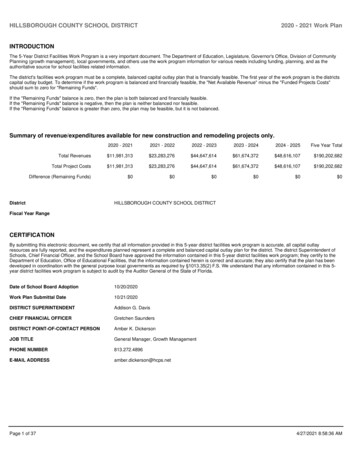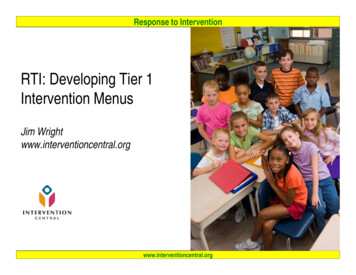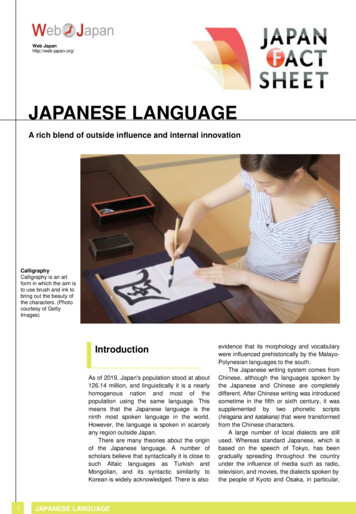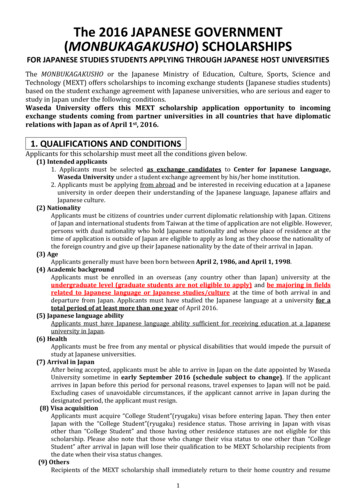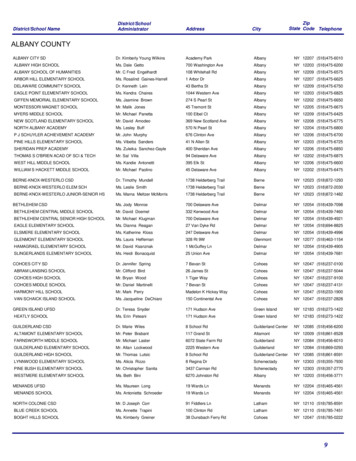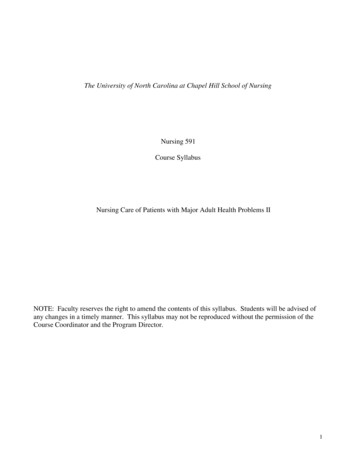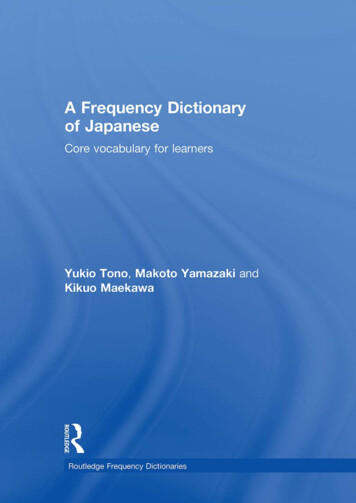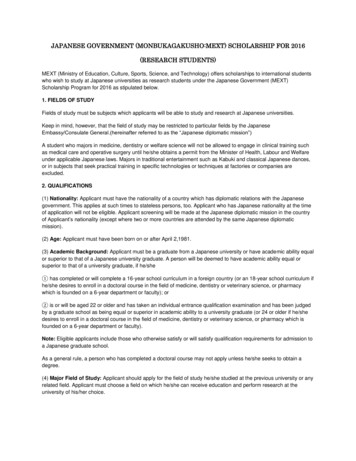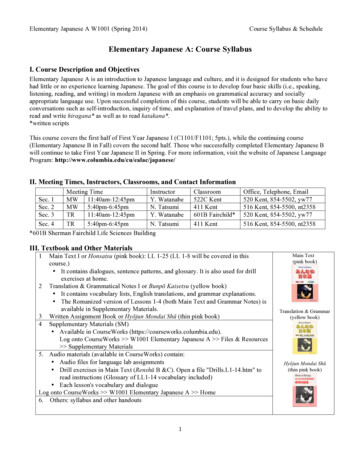
Transcription
Elementary Japanese A W1001 (Spring 2014)Course Syllabus & ScheduleElementary Japanese A: Course SyllabusI. Course Description and ObjectivesElementary Japanese A is an introduction to Japanese language and culture, and it is designed for students who havehad little or no experience learning Japanese. The goal of this course is to develop four basic skills (i.e., speaking,listening, reading, and writing) in modern Japanese with an emphasis on grammatical accuracy and sociallyappropriate language use. Upon successful completion of this course, students will be able to carry on basic dailyconversations such as self-introduction, inquiry of time, and explanation of travel plans, and to develop the ability toread and write hiragana* as well as to read katakana*.*written scriptsThis course covers the first half of First Year Japanese I (C1101/F1101; 5pts.), while the continuing course(Elementary Japanese B in Fall) covers the second half. Those who successfully completed Elementary Japanese Bwill continue to take First Year Japanese II in Spring. For more information, visit the website of Japanese LanguageProgram: http://www.columbia.edu/cu/ealac/japanese/II. Meeting Times, Instructors, Classrooms, and Contact InformationMeeting TimeInstructorSec. 1MW 11:40am-12:45pmY. WatanabeSec. 2MW 5:40pm-6:45pmN. TatsumiSec. 3TR11:40am-12:45pmY. WatanabeSec. 4TR5:40pm-6:45pmN. Tatsumi*601B Sherman Fairchild Life Sciences BuildingClassroom522C Kent411 Kent601B Fairchild*411 KentOffice, Telephone, Email520 Kent, 854-5502, yw77516 Kent, 854-5500, nt2358520 Kent, 854-5502, yw77516 Kent, 854-5500, nt2358III. Textbook and Other Materials1Main Text I or Honsatsu (pink book): LL 1-25 (LL 1-8 will be covered in thiscourse.) It contains dialogues, sentence patterns, and glossary. It is also used for drillexercises at home.2 Translation & Grammatical Notes I or Bunpō Kaisetsu (yellow book) It contains vocabulary lists, English translations, and grammar explanations. The Romanized version of Lessons 1-4 (both Main Text and Grammar Notes) isavailable in Supplementary Materials.3 Written Assignment Book or Hyōjun Mondai Shū (thin pink book)4 Supplementary Materials (SM) Available in CourseWorks (https://courseworks.columbia.edu).Log onto CourseWorks W1001 Elementary Japanese A Files & Resources Supplementary Materials5. Audio materials (available in CourseWorks) contain: Audio files for language lab assignments Drill exercises in Main Text (Renshū B &C). Open a file "Drills.L1-14.htm" toread instructions (Glossary of LL1-14 vocabulary included) Each lesson's vocabulary and dialogueLog onto CourseWorks W1001 Elementary Japanese A Home6. Others: syllabus and other handouts1Main Text(pink book)Translation & Grammar(yellow book)Hyōjun Mondai Shū(thin pink book)
Elementary Japanese A W1001 (Spring 2014)Course Syllabus & ScheduleIV. Study HoursYou are expected to study for about 1 to 1.5 HOURS every day outside of class. This self-study includes but is notlimited to reviewing class materials, preparing for the next class (e.g., memorizing new vocabulary and reading newGrammar Notes), and doing homework as well as drill exercises in Main Text.V. Course Policies If you are unable to attend the class for legitimate reasons, submit a written explanation (such as adoctor's note). Without proof, you will receive 0 for both attendance and quiz.If you are absent from the class, it is your responsibility to contact the instructor to find out aboutany changes to course schedule.If you are absent for no compelling reasons more than twice, one percent will be deducted fromyour final grade each time you are absent. For example, if you have missed class five times, 3 %will be deducted from your final grade, which could lower your final grade by as much as one lettergrade.Absence from class for a week or more without contacting the instructor will be regarded asunofficial withdrawal from the course.No make-up quizzes will be administered. If you are late for a quiz, you will receive 0.Homework and lab assignments should be submitted on time. We will accept one late submissionper semester without penalty. After that, no credit will be given for late submission. Even if you arelate, however, you are still encouraged to submit your assignments so as to get feedback andcomments from your instructor.If you failed to submit your assignments on time due to an emergency or for a legitimate reason,you must submit written proof.The date of Final Examination will be announced later. The date may be DIFFERENT from thelisting on the university website. Don’t book your flight until the JAPANESE PROGRAMannounces the final exam day! Your flight schedule or travel schedule is not a legitimate reason toreschedule your final exam.We are strict with these policies because learning a foreign language requires constant practice and commitment.Having said that, learning Japanese is fun and rewarding. If you have any concerns or questions, come to see us!Please note that registration (R) credit, auditing, or a PASS/FAIL grade is NOT allowed.VI. Language Laboratory AssignmentsLanguage laboratory assignments are listening homework. You will not go to a lab. Instead, you will do listeningexercises on your own and submit worksheets to the instructor.Audio files are available on the web (Click the first link on CourseWorks), while worksheets can be found inSupplementary Materials (Look for a folder entitled “E. Language Lab pp.47-101”).2
Elementary Japanese A W1001 (Spring 2014)Course Syllabus & ScheduleVII. Grading SystemFinal Exam (written exam and oral interview)Midterm ExamRegular ExamsLanguage Lab.QuizzesAttendance and Class PerformanceAttendanceClass Performance: Active participation in terms of quantity and qualityHomeworkCompositionTotal93 % and above90 87 83 80 77 73 70 60 below 6020 %15 %15 %10 %15 %10 %13%2%100 %AAB BBC CCDFYour final grade must be at least B- to advance to Elementary Japanese B in the fall semester.VIII. EALAC Statement on Academic Integrity for Course Syllabi*Students are expected to do their own work on all tests and assignments for this class and act in accordance with theFaculty Statement on Academic t) and Honor ) established by the students of Columbia College and the School ofGeneral Studies. Because any academic integrity violation undermines our intellectual community, students found tohave cheated, plagiarized, or committed any other act of academic dishonesty can expect to fail the class and may bereferred to the Dean’s Discipline process.It is students’ responsibility to ensure their work maintains the standards expected and should you have any questionsor concerns regarding your work, you can:a)Talk with your TAb)Ask the instructorc)Refer to the Columbia University Undergraduate Guide to Academic Integrity, which includes informationon what constitutes a violation of academic integrity and specific guidance on how to cite academicintegrity.*Japanese Program will follow the EALAC Academic Integrity Statement3
Elementary Japanese A W1001 (Spring 2014)SM: Supplementary Materials WA: Written Assignment orDateIn-Class Activities1/21 T 1) Orientation1/22 WClassroom InstructionsPronunciation Drills etc.1/23 R 2) L.11/27 MHiragana あ[a] そ[so]1/30 R2/3 M5. N1 の(no) N2 [Lesson 2]Homework! L.1 VQ(Vocabulary Quiz)5. N1 の(no) N2 [Lesson 1]! L.2 VQ1. これ(kore) / それ(sore) / あれ(are)! Hiragana sheet #1-2:あ[a] そ[so](SM or Supplementary Materialspp.190-191)! Hiragana sheet #3-4:た[ta] ほ[ho](SM pp.192-193)! Lab. L1 (SM pp.47-53)Japanese Chat Club (403 Kent; 1:30-2:30)5) L.2Hiragana Special Writing 1(voiced consonants, glides)2/6 R 6)L.22/10 M Hiragana Special Writing 2(long vowels, doubleconsonants)2/4 T2/5 W2/7 F2/11 T2/12WQuizzes (tentative)1. N1 は(wa) N2 です(desu)N1 は N2 じゃありません(ja arimasen)2. 〜さん(san)3. S か(ka)4. N も(mo)1/31 F) [Thin Pink Book]Grammar Patterns1/28 T 3) L.11/29 WHiragana た[ta] ほ[ho]4) L.2Hiragana ま[ma] ん[n](2.この(kono) /その(sono) /あの(ano) N! Hiragana Quiz(あ ほ) ! Hiragana sheet #5-6:ま[ma] ん[n](SM ��ません(sō ja arimasen)4. S1 か、S2 か6.そうですかJapanese Chat Club (403 Kent; 1:30-2:30)! Hiragana Quiz(ま ん) ! Hiragana sheet #7-8: voiced consonants,glides (SM ��/そちら/あちら2. N1 は N2 (place)です! L.3 VQ2/13 R 8) L.32/17 MIntroducing self/others3.どこ/どちら! Hiragana Quiz2/18 T 9) L.32/19 WKatakana (アーソ)5.こ/そ/あ/ど system6. おくに7)L.3! Hiragana sheet #9-11: long vowels,double consonants(SM pp.198-200)(All Hiragana IncludingSpecial Writing 1 & 2)4. N1 の N2 [Lesson 3]! LL.1-3 Grammar Quiz4! LL. 1&2 Written HW"Worksheets in SM pp.42-46"Audio files in “the Audio Drill Files”
Elementary Japanese A W1001 (Spring 2014)SM: Supplementary Materials WA: Written Assignment or() [Thin Pink Book]Date2/20 R2/24 MIn-Class Activities10) L.4Katakana (ターホ)Grammar Patterns1.いま〜じ〜ふんです5.N1 から N2 まで7.S ねQuizzes (tentative)! L.4 VQ 1(p.30)Homework / Lab.! Lab. LL.2&3(SM pp.55-65)2/25 T2/26W11) L.4Review (LL.1-3)Katakana (マーン)12) Exam (LL.1-3)2.V ます! L.4 VQ 2(p.31)! L.3 WA pp. 3-42/27 R3/3 M3/4 T3/5 W3/6 R3/10 M3/7 F3/11 T3/12 W"ひょうじゅんもんだいしゅう(thin pink workbook)4.N(Time)に V13) L.4Katakana Special Writing! Katakana Quiz(ア ン)14) L.5! L.5 VQ 1 (p.36)3.V ます/V ません/V ました/V ませんでした6. N1 と N2Time /かえります5.いつ6.S よJapanese Chat Club (403 Kent; 1:30-2:30)15) �した! Lab. L.4 (SM pp.66-73)" From L.5 on, writeanswers in hiragana! L.5 VQ 2 ります! L.4 WA pp. 5-6! L.4 Content Questions(SM p.155)4.N(Person/Animal)と V3/13 R3/24 M3/17-213/25 T3/26 W! L.6 VQ 1 (p.42)! Lab. L.5 (SM pp.74-82)! Grammar Quiz (LL.4-5)16) L.61.N を V(Transitive)How to Use Genkōyōshi2.N をします(Japanese Composition Paper)Spring Recess17) L.63.なにをしますかReview for Midterm4.なん and なに! L.6 VQ 2 (p.43)5.N(Place)で V3/27 R3/31 M3/28 F18) Midterm Exam (LL.1-5)Japanese Chat Club (403 Kent; 1:30-2:30)5! L.5 WA pp. 7-8! Composition (Rough Draft)
Elementary Japanese A W1001 (Spring 2014)SM: Supplementary Materials WA: Written Assignment orDate4/1 T4/2 WIn-Class Activities18) L.64/3 R4/7 M19) L.74/8 T4/9 W20) L.7() [Thin Pink Book]Quizzes (tentative)Homework / Lab.! Katakana Quiz (All Katakana! L.5 Content Questions (SM p.156)Including Special Writing)Grammar Patterns6.V ませんか7.V ましょう8.お〜1.N(Tool/Means)で V2.Word/Sentence す, etc.! L.7 VQ 1 (きります〜かみ)! Grammar Quiz (L6)! L.6 WA pp. 9-10! L.6 Content Questions (SM p.157)! L.7 VQ 2 (はな〜おみやげ)! Composition (Final Version)! Voice-recorded Composition (Email4.N(Person)にもらいます, etc.3. N (person) にあげます, etc.4. N (person) にもらいます, etc.5.もう V ました1. Adjectives2. N は な-adj./ い-adj.です4/10 R4/14 M21) L.84/11 F4/15 T4/16 WJapanese Chat Club (403 Kent; 1:30-2:30)22) L.84. とても/あまりReview (LL.1-7)5. N はどうですか4/17 R4/21 M4/22 T4/23W23) Exam (LL.1-7)4/24 R4/28 M4/25 F25) Oral Interview24) L.8the instructor)! L.8 VQ 1(p.54)! Lab. LL.6-7 (SM pp.83-93)! Composition Grade Sheet Due 4/14(M&W classes only)! L.8 VQ 2(p.55)! L.7 WA pp. 11-12! Composition Grade Sheet Due 4/15(T&R classes only)3. な-adj.な N, い-adj.(い)N6. N1 はどんな N2 ですか7. S1 が、S28.どれ! L.7 Content Questions (SM p.158)は る ま つ り (Spring Festival)26) Review (LL.1-4)4/29 T! Lab. L.8 (SM pp.92-102)4/30 W5/1 R27) Review (LL.5-8)! L.8 WA pp.13-145/5 M! L.8 Content Questions (SM p.159)Final Examination Date to be announced. Note: The date for the final exam may be DIFFERENT from the web listing. Don’t book your flight until theJAPANESE PROGRAM announces the final exam day!6
Elementary Japanese A is an introduction to Japanese language and culture, and it is designed for students who have had little or no experience learning Japanese. The goal of this course is to develop four basic skills (i.e., speaking, listening, reading, and writing) in modern Japanese
